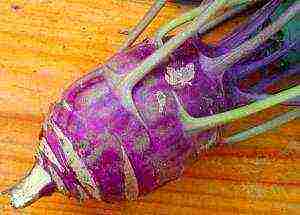Content
- 0.1 WHAT EDIBLE GREENS
- 0.2 YOU CAN GROW ON A WINDOWSILL.
- 0.3 BORAGO is a cucumber herb with juicy stems.
- 0.4 ROSEMARY - the soul of European cuisine on your windowsill.
- 0.5 OREGANO - herb for sauces.
- 0.6 THYME is a medicinal herb on your windowsill.
- 0.7 MAJORAN - greens are not like all the others.
- 0.8 BASILIC ON THE WINDOWSILL.
- 0.9 CRESS SALAD grown at home.
- 0.10 WHEN TO PLANT GREENS on windowsills.
- 0.11 WHERE TO PLANT GREENS - for growing on a windowsill
- 0.12 HOW TO PLANT GREENS ON THE WINDOWSILL.
- 0.13 NOTE -
- 0.14 some greens can be propagated NOT ONLY BY SEEDS ...
- 0.15 HOW OFTEN WATER GREENS ON THE WINDOWSILL
- 0.16 ONION ON THE WINDOWSILL - HOW TO GROW.
- 1 1. Green onions
- 2 2. Watercress
- 3 3. Lettuce
- 4 4. Parsley
- 5 5. Chive bow
- 6 Let's summarize
- 7 What greens can you grow at home?
- 8 General rules for growing greens
- 9 How to grow parsley?
- 10 Growing spinach and onions
- 11 Growing lettuce and dill
Good afternoon - today we will talk about how to grow greens at home, on the windowsill or on the balcony. I'll show you how to plant and how to care for edible herbs grown in boxes and pots at your window. I will also introduce you to spicy herbs that are most often used in the cooking of Europe and Asia... We will find out what juicy leaves and stems can be added to our vitamin salads and other dishes.
WHAT EDIBLE GREENS
YOU CAN GROW ON A WINDOWSILL.
Before we start talking about the rules of sowing growing greens on windowsills ... Let me first tell you WHAT wonderful greens you can grow all year round on your windowsill. Why each herb is useful and how to use it in cooking.
Let's make a brief overview of the greenery with a photo. And to make you want to grow greens more at home - I will give not only a photo of herbs on the windowsill - but also photographs of dishes made with these herbs.
I won't talk about parsley, salad, and dill. Everyone is already familiar with this greenery since childhood.
I want to make you fall in love with other new edible herbs ... who knows, perhaps you will discover an amazing new flavor for your family cooking.
So ... let's get acquainted ...
BORAGO is a cucumber herb with juicy stems.
Borago (or "cucumber grass") - it really tastes like our cucumber. It has double leaves and green flowers. She was loved in France (there she is called "the grass of joy" - her blue small flowers were put in a glass of wine, they taste sweet.
Borago produces lush leaves with thick juicy stems - they are eaten directly from plump stems.
The leaves are harvested even before flowering - they make vitamin salads, add to okroshka, garnish with fish and meat, brew with tea, put in wine or hot punch.
ROSEMARY - the soul of European cuisine on your windowsill.
Rosemary widely used in Italian and French cuisine. It is seasoned with lamb, poultry, potato casserole, vegetable stews. Meat for grilling is even strung on sprigs of rosemary - and the stems of this herb transfer their aroma to the kebab.
OREGANO - herb for sauces.
Oregano - added to marinades, sour cream or mayonnaise sauces. Grind with thyme, basil and olive oil - and this dressing is used to flavor any summer salads or spaghetti. It is also put into pizza.
THYME is a medicinal herb on your windowsill.
Thyme (thyme) - fresh leaves are added to salads, meat and vegetables are stewed with thyme. Thyme is added to omelets, to cheese dressings for casseroles.
Tea with thyme (i.e. with thyme) helps stop coughing, relieves hangover syndrome, and eliminates digestive problems.
MAJORAN - greens not like all the others.
The ancient Greeks adored marjoram - they considered it a magical herb, they covered sacrificial altars with it. Marjoram enhances SEXUAL ATTRACTION - in ancient times it was actively used by men - by adding it to wine, to hot alcoholic drinks (such as modern punch and mulled wine).
In our time - the entire sausage industry in Germany - prays for this herb - it is generously added to all German sausages. Maybe that's why the Germans are considered sex-addicted ... it's just that marjoram in sausages has such an effect on them.
Add to minced meat - to fillings for meat rolls - to soups - to fish salads. When the diet restricts salt intake, this herb is an excellent substitute for it.
Very quickly, marjoram heals NASMORK - rub the leaf with your fingers to bring it to the nose - you start sneezing and the nasal sinuses are immediately cleared - the swelling of the mucous membrane is removed. Used for diseases of the respiratory tract. Reduces CHOLESTEROL.
BASILIC ON THE WINDOWSILL.
Basil - a well-known spice of very wide application - they put it everywhere... Fresh in salads. In vegetable stew and meat roast - 3 minutes until cooked. It is an ideal seasoning for fish - for liver - for pickles. It is added to minced meat for sausages - to meat fillings for pies and casseroles, as well as to omelets.
CRESS SALAD grown at home.
Watercress - a herb containing just a storehouse of vitamins - just the entire alphabetical-vitamin series. Watercress is used to treat many skin inflammations (including purulent ones) - its leaves heal wounds. It also helps in the treatment of cataracts and other eye diseases. Used in the treatment of prostatitis. It is recommended to eat watercress leaves for depression and nervous disorders.
Cream soups, sauces, and gravies are prepared from cress leaves crushed in a blender. This herb is good in omelets and casseroles. Ideal for fresh salads. Suitable as a side dish for meat and fish dishes.
Below I will talk about how to grow watercress at home - it has an original way of planting.
WHEN TO PLANT GREENS on windowsills.
You can start a sowing company in any season of the year. But of course that in the summer period (with long sunny days, warmed up window sills - sowing will quickly sprout and abundant greenery. While in winter - all these processes will occur much slower.
If you sow greenery in spring and summer, then all that is required for it is systemic watering and a little bit of vermicompost (for nutrition).
WHAT IS BIOHUMUS - and why should it be added to the soil for planting greenery.
Vermicompost is a natural biological fertilizer. Which gives strong immunity to landings. Accelerates seed germination. Accelerates growth and maturation of plants. Prevents the accumulation of nitrates through plant roots. Protects against bacterial and putrefactive diseases.
When added to the soil, biohumus gradually releases nutrients to the plant ... during all its growth stages.
There are already soils on sale - which include vermicompost (read the composition of the soil on the package).
WHERE TO PLANT GREENS - for growing on a windowsill
Preparing the soil. We mix vermicompost with coconut fiber (proportion 1: 2). So we will not get pure vermicompost - but a good substrate, which will gradually give its nutrients to your green plantings.
We prepare containers - pots (with a hole in the bottom), or drawers, or other decorative bowls-cups (if you want your windowsill to look elegant.
The depth of the selected container should be at least 15 cm - if you want to harvest a serious crop.
At the bottom we put 2-3 cm of drainage layer (for the outflow of excess water from the ground) - as drainage, you can use expanded clay balls or even just small pebbles or gravel will do.
You can immediately sow in box pots. And you can first in peat tablets or cups - and then transplant them into large pots.
HOW TO PREPARE THE SEEDS BEFORE PLANTING.
Many people like to test seeds for germination - by dropping them into water. And throwing out floating seeds (like dummies). But in fact, this principle no longer works. Currently, there are varieties and hybrids in which floating seeds germinate in the same way as those settled on the bottom. Therefore, this rule can be omitted.
And just soak the seeds in warm water - for your own pleasure.
FOR PETRUSHKA - such a stay of seeds in warm water is even beneficial. There is a lot of essential oil in its seeds - it prevents the seeds from absorbing moisture and emerging. Therefore, they need to be kept in water - so that the essential oils are washed out of the seeds and increase their germination.
HOW TO PLANT GREENS ON THE WINDOWSILL.
SEEDS are spread on prepared filled with vermicompost, and slightly crushed soil with your fingers. The laid out seeds are sprinkled with earth - a layer no more than 1 cm.
Light-sensitive seeds (small-small) and you do not need to fall asleep at all, but lightly crush it with your finger (stick to the soil) and leave it to lie.
After disembarkation - we need to sprinkle our "bed" with water and cover with a plastic transparent bag to create a greenhouse - so that moisture does not evaporate quickly. In the bag, make a few holes for air or just leave the bag ajar - so that there is no unnecessary discussion in the bag.
Such a man-made greenhouse - will create uniformly humid climate and will accelerate seed germination.
After seed germination (1.5-2 weeks after sowing) - you can remove the greenhouse... But it is better to do this not in the evening, but in the morning ... So that the plants get used to the temperature with a gradual cooling of the day towards evening.
After seed germination - a month later (when they are already standing stretched out on their thin stems) - you need make a bed of earth - another 2 cm.
NOTE -
some greens can be propagated NOT ONLY BY SEEDS ...
ROSEMARY they are also propagated by dividing the bush, cuttings, layering.
PETRUSHKA AND CELERY - also planted with roots. If you plant parsley not with seeds - but with roots - then it will very quickly give its greens.
BASIL - reproduces by leaves. We cut off the leaves with cuttings - we plunge them into the water and wait for the cutting of the leaf to sprout root processes.
BORAGO - sown with standard seeds. The distance between the seeds is at least 6 cm - so that there is where to plow the leaves. Borago does not like a lot of sun - this green is ideal for windowsills with access to the north, west, east.
CRESS SALAD - these are greens that can be planted without land - on a wet flannel cloth or in a scattering of expanded clay balls.
HOW OFTEN WATER GREENS ON THE WINDOWSILL
In the first month of growth - we water a little, but often. The ground should be constantly moist (but not wet) ... The greenhouse helps us with this. In the course of the day, they opened the bag ... splashed water from the pshikalki and covered the film again.
In the following months, watering is carried out as needed. More often in summer… less often in winter.
You can arrange a self-irrigation system for greenery ... so that the earth itself absorbs moisture as needed
FOR GREENS TO GROW LUSH
Every day - you need to turn the pots with sprouts - 180 degrees - so that the plant does not bend in one direction (towards the sun).
Onions, dill and parsley do not require a lot of light. Therefore, pots with these green bushes can be placed on the edge of the windowsill - and other sun-loving plants can be placed closer to the window.
ROSEMARY growing in bushes in pots - has a tendency to grow with rhizomes (roots will climb into the drainage layer). Therefore, it is recommended 2 times a year - take the plant out of the pot - cut off part of the roots with a knife along with the ground.Put a layer of drainage back on - add some soil - and return the rosemary bush to the pot. Such a transplant stimulates the emergence of new green shoots. ALSO rosemary requires feeding (with a weak solution) every 2 weeks.
BASIL - after the appearance of 6 leaves - pinch off. So that he bushes to the sides. Then the branches that have gone to the sides - we pinch in the same way after 5 leaves - so that they also start up their side shoots. And so on until we create the lush crown of the basil bush we need.
ONION ON THE WINDOWSILL - HOW TO GROW.
And we will tell you separately how to get fresh onion feathers on the windowsill - by germinating the bulbs in water.
Pour water into cups (glasses, jars) so that the onion dropped into the container is immersed in it no more than half. And leave it like that in the water. After two days, the bulb will begin to give a feather. To make the whole composition look beautiful, you can arrange such plantings of onion greens - with decorative materials.
And here's an idea for using eggshells to sprout bulbs. Pour water into the shells. We lower the small bulbs outside and wait for the green harvest.
These are the simple rules for growing greenery in your home on a windowsill or balcony.
Successful sowing and tasty harvest.
Olga Klishevskaya, specially for the site "Family Heap"
to your site.
Home mini-gardens
on windowsills are now very popular. We talked about the most important rules that allow you to grow almost any vegetables in such conditions in the article
"10 secrets of the home garden"
... And this time I propose to discuss the best crops for home "beds" - those that do not require special worries, but at the same time they invariably delight with the harvest in the shortest possible time. I present my list and look forward to your comments.
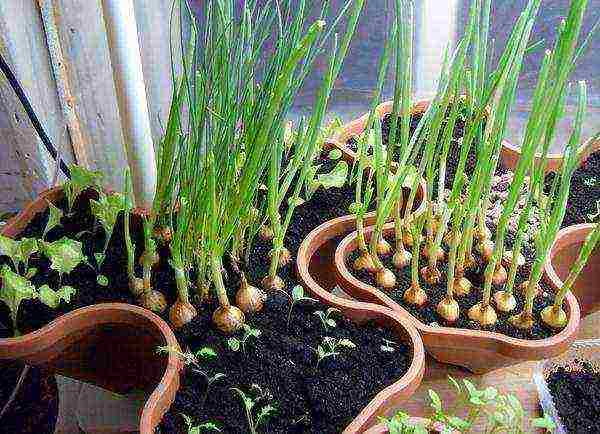
Home garden. Photo by the author
1. Green onions
Topping my "hit parade", of course, green onions. Probably, at least once in his life, everyone grew it on the windowsill, even if only in childhood - out of curiosity. This is an ideal plant for a home garden: fast growing, unpretentious, useful.
As planting material you can use both onion sets (large fraction - samples), and ordinary onion-turnip. I've tried both; from the seed (or small turnip), the yield, of course, is less - the bulb is depleted faster. But the feather - for my taste - is softer and more tender. In addition, the small onion takes up less space when planting. A large onion produces more greenery, its feather is usually larger, and it takes longer to harvest.
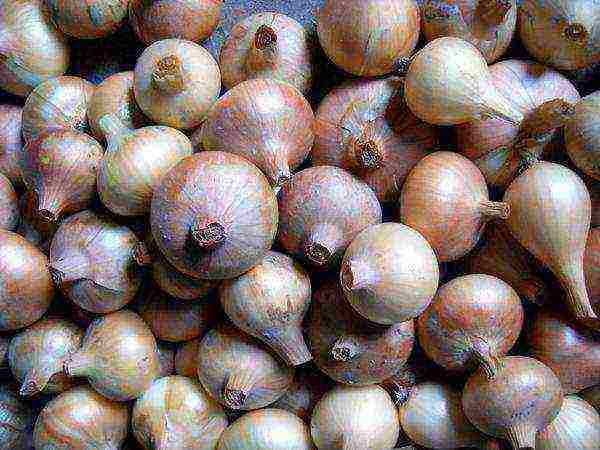
Small bulbs can also be used as planting material. Photo by the author If you do not have enough of your own turnip onions to use it for forcing, you can specially buy it in the autumn of samples - in supermarkets and specialized country shops they sell it at the end of the season with good discounts. I would not recommend purchasing such planting material for a turnip, but for distillation - just right.
You can plant onions for distillation in small containers with water or nutrient solution (so that the onion does not fall into the water, but only touches it) or into the ground. I personally like the second option more: the bulbs on the water often begin to rot, exuding a specific aroma; with unpaved I have never had such an incident.
In the soil for planting, I certainly add a hydrogel soaked in a solution of Gumi (this biological product strengthens plants, additionally nourishes them, and increases resistance to diseases). In room conditions, the soil substrate dries out quickly, and the hydrogel prevents the bulbs from suffering from moisture deficiency.
To always be with the harvest, it is best to plant an onion regularly - every 10-14 days... Then, by the time the crop is fully harvested from the first "bed", the greens will ripen on the next - and so on until spring.
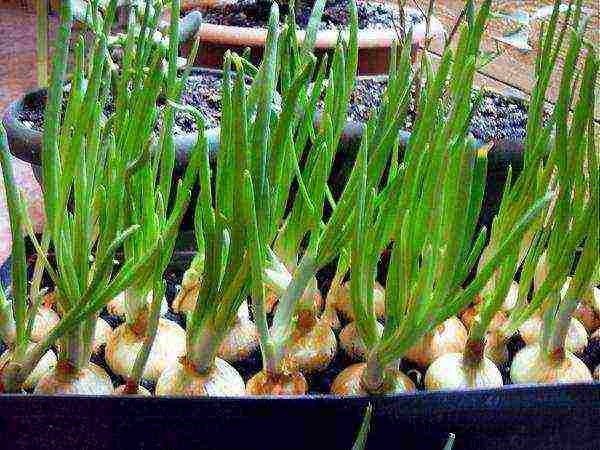
A box with green onions.Photo by the author I use small plastic boxes for planting. I pour expanded clay at the bottom (there are no holes for the drain of excess moisture in the boxes, so drainage is necessary), on top - soil with hydrogel up to about half of the box. Having slightly compacted the mixture, I plant the bulbs in it close to each other, without burying them in the soil. I water it abundantly - that's all.
Since I plant usually already sprouted bulbs, the harvest does not have to wait long. I do not carry out any specific procedures (pruning, soaking, etc.), which are often recommended to be performed when forcing onions on a feather, - I do not see a special need, and there is always not enough time. But if you, friends, have such an experience, and you see the benefits of such processing, be sure to share your opinion in the comments - the recommendations of practitioners are always invaluable!
You can also read our publications:
- How to grow delicious onions on a windowsill - secrets and subtleties
- A vegetable garden on the windowsill: we grow onions, garlic and carrots for greens
- Forcing onions in special boxes: the experience of Yulia Minyaeva
- Growing green onions in a plastic bottle
2. Watercress
I will say right away: I myself have grown this plant only once - I was not impressed by its gastronomic properties. Personally, I liked mustard leaf more - it is also a very undemanding cruciferous plant. But taste, as you know, is a purely individual thing, and I still take the liberty of recommending watercress as one of the best crops for home gardens. Why?
- Firstly, he - like the bow - is extremely unassuming. Those who do not have the ability or desire to spend time on laborious care of the "beds" on the windowsill will certainly appreciate it, I suppose.
- Secondly, it is very early ripening: already in 2-3 weeks after the emergence of shoots (and they will not be long in coming) you will be pleased with young vitamin greens.
- Thirdlynature has endowed watercress with many beneficial properties: regular consumption of this culture helps to normalize blood pressure, improve digestion and sleep. It was used as a remedy for scurvy, and anemia and vitamin deficiencies were treated with juice.
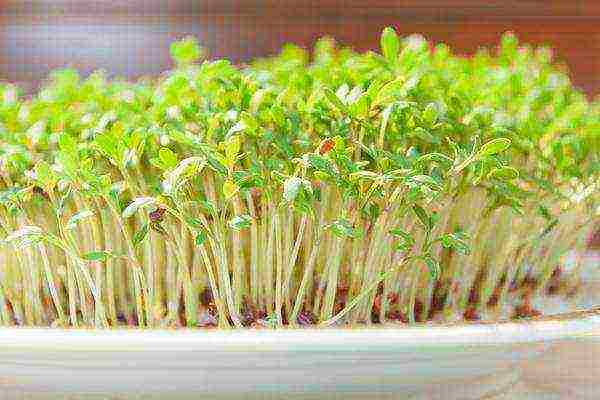
Watercress - Harvest in Two Weeks If you have children, try sowing watercress with them - at least for the sake of experiment. This plant is one of those with which it is worth starting the introduction to gardening, because failure is almost impossible!
Watercress grows successfully on windowsills even in winter - it is very cold-resistant (the ideal temperature for it is from +15 to +18 degrees) and is not picky about light. The only thing he needs is regular moistening of the soil and air, since this plant does not like drought. To keep the greens on the table constantly, it is recommended to sow the next portion of watercress every 7-10 days.
I recommend reading more about growing watercress in the article How to quickly and easily grow watercress on a windowsill.
3. Lettuce
As a big salad lover, I could not, of course, ignore it. This culture is a little more demanding than green onions and watercress, but for the juicy greens it is worth the effort. What do you need to consider?
- Firstly, lettuce at home needs additional lighting - this is a light-loving culture. Lack of lighting will lead to early peduncle formation. The problem is partially solved by the choice of varieties. Lollo Rossa and Lollo Bionda (my favorites) proved to be quite good for me; recommend for home gardens also varieties New Year, Vitamin, Emerald lace.
- Secondly, lettuce reacts painfully to drought and heat: the leaves become coarse and bitter, flower stalks form quickly.
- Thirdly, lettuce shoots need to be thinned. It is recommended to do this twice: a week after the emergence of seedlings at a distance of 1-2 cm between seedlings, and in the phase of 2-3 true leaves - at a distance of 4-5 cm.If you thicken the crops, the plants will stretch out, weaken, and you most likely will not see the harvest.

Young lettuce plants. Photo by the author From growing head lettuce at home, it is better to refuse until there is enough experience: they are more demanding and need more careful care than their leafy counterparts, and their growing season, as a rule, is longer. To be honest, I did not even try to grow lettuce at home to the standard sizes that it reaches in the garden - tender young leaves were enough for me. But, if space permits, and there are conditions suitable for a salad, it is quite possible to get large outlets.
4. Parsley
You can get parsley greens at home in two ways: sowing seeds in the ground and forcing from prepared roots. The second method, although it requires some preliminary preparation, is generally simpler. Even if you have not prepared planting material since autumn, you can look for high-quality root crops for distillation in the vegetable departments of stores.
For our purposes, absolutely healthy parsley roots of medium size (30-60 g in weight) without signs of wilting are suitable. They must have an apical bud - heavily trimmed plants will not produce greenery.
Having well moistened the soil in a box or flower pot, we plant root crops, covering their tops with soil. Too long can be cut (sprinkled with charcoal cut to avoid rot) or planted obliquely. The latter option is considered even more preferable than the regular fit.

Parsley from seeds at home. Photo by the author If you grow parsley from seeds, you need to take into account two nuances: the plant is photophilous, and its seeds germinate rather slowly. When sowing, the containers with parsley were not very well located relative to the light source, and the seedlings immediately began to stretch out. And it was possible to accelerate germination thanks to the preliminary soaking of the seeds in a solution of Gumi (I will certainly tell you more about this wonderful preparation somehow).
Parsley is not afraid of cold weather, so it feels great on the windowsill. The plant also does not impose special requirements for moisture - we water it as needed, depending on the conditions in the room. I already traditionally add hydrogel for all such plantings, so I usually don't have any problems with watering my home garden.
Read more about growing this plant at home in the article How to grow parsley on a windowsill.
5. Chive bow
This crop will require a little preliminary preparation: in order to get a harvest all winter, it is necessary to prepare planting material for forcing... Small curtains of chives are dug up and, having cut off the feather, are planted in boxes or pots, which are stored in the basement or on the balcony.
In winter, they are brought into a warm room as needed and placed closer to the light. The feather grows quickly on chives; it can be plucked from the bush selectively or cut off completely. I love the taste - it is softer and softer than regular green onions, so (given the ease of growing) I have no hesitation in putting chives on my list of the best crops for home gardening.
As my experience has shown, at home, a crop from one plant can be obtained twice, after which it is depleted, even with good care and feeding. Therefore, it is wise to prepare several containers of planting material in order to grow greens throughout the winter. Well, in early spring, chives are one of the first to sprout in the garden.

Chives greens - a crop from a home garden. Photo by the author It is advisable to take planting material for forcing from those plantings that you intend to thin out or completely remove - the plants used for forcing are no longer restored, and after the final harvest they are removed.
An important nuance: chives are very sensitive to moisture - with a lack of moisture, the feather coarsens and begins to noticeably bitter, flower stalks form quickly. I set up an experiment: I planted the same cuttings in the same containers; one - in a regular soil, the second - in a mixture of soil with hydrogel. Differences in the growth and development of plants, visible, as they say, with the naked eye, confirmed the hypothesis about the benefits of using a hydrogel in this case as well.
Let's summarize
Here's a list. I tried to grow radishes, and dill, and cilantro at home; in childhood, she planted beans and peas. I drove out the greens of beets and carrots, tried to preserve the basil transplanted from the garden ... In a word, there were many different experiments, and the listed crops were among my favorites.
Decisive when choosing there were factors such as ease of cultivation and undemanding conditions. I will repeat what I have already said more than once: almost any garden culture can be grown at home, but not everyone has the opportunity for this. Therefore, the best plants for a home garden are those that anyone can easily grow.
Let me remind you: A vegetable garden on a balcony or windowsill: the peculiarities of home gardening are the topic of another lesson in our Academy of the gardener. The recommendations of the specialists of the Agrofirm Search, together with whom we organized this project, will help beginners quickly master the wisdom of gardening, and experienced gardeners - to systematize and deepen their knowledge.
What do you grow on the windowsills? What do you agree with in my story, and what could you argue with based on your own experience? Share your opinion in the comments, tell us about your favorite plants!
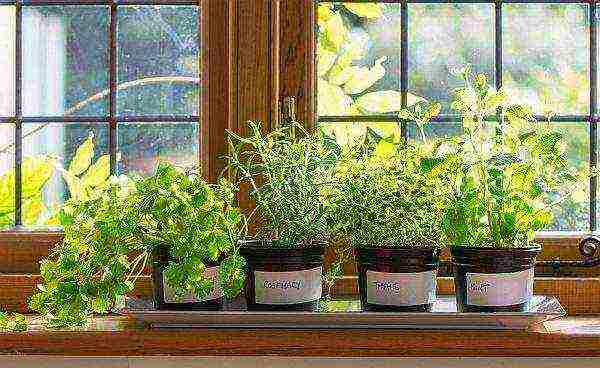
When planning to master the cultivation of greenery on the windowsill in winter, autumn and spring, lovers of indoor beds consider three indisputable leaders: dill, parsley and green onions.
These plants are suitable as a condiment for many dishes. They gained their popularity due to their ease of care, versatility and taste. How to grow popular and not very well-worn spicy herbs in the kitchen with your own hands, what to look for in order for the crop to please the eye and taste?
- General recommendations for growing herbs on a windowsill
- Requirements of different greenery
- How to grow parsley on the window
- Features of growing dill in an apartment
- Fragrant basil on the window
- Ideal salad variety for home growing
- How to get green onions quickly in winter
- Fragrant mint in the home kitchen
- What else can be grown on a windowsill in an apartment
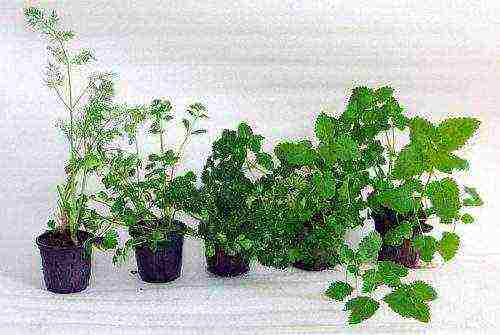
General recommendations for growing herbs on a windowsill
Almost any greenery can be grown on the windowsill in the apartment. The main thing is to choose the right variety and comply with the plant's requirements for soil composition, air humidity, watering, and temperature conditions.
Important:
- Choose unpretentious varieties, or better hybrids specially bred for indoor conditions. This will make it easier to care for and increase the chances of a crop. If you are not confident in your abilities and want to get a quick result, buy not seeds, but ready-made seedlings in pots.
- Practical greenery pots on the windowsill should be rectangular. Use a wide and shallow dish. Plastic containers are quite suitable, they are lightweight and practical to clean. Ideal for multiple use. Read more about the choice of containers here.
- Buy a lightweight, well-drained soil for your greenery. You can prepare a mixture of vermicompost with coconut fiber. The proportion should be 1: 2. At the bottom of the pot, be sure to pour a layer of small stones, expanded clay, crushed foam, or make another drainage.
- If it's cool or blowing outside, use plastic hoods to create mini greenhouses. You can buy ready-made or do it yourself from a package.
- The optimal daylight hours for green pets are 10-13 hours. In winter, there is not enough light, especially on the north side.To illuminate the greenery on the windowsill, install lamps, it is better to buy fluorescent or special phytolamps. Regular fixtures will not work.

- Do not neglect top dressing, pick up complexes of mineral fertilizers for watering every 2-3 weeks. But make the solution less concentrated than for open ground.
- Spray green pets every other day or more with a fine spray, especially if the air in the apartment is dry.
- Do not be lazy to turn the pots in different directions to the light so that the plant develops evenly.
- To grow greenery to the apartment, it is better to take a window sill in the kitchen. The bedroom is not the best place for frequent watering, spraying, and fertilizing. In the bathroom, herbs will look ridiculous; other plants are more appropriate for her landscaping.
If you do not want to be limited only to greenery, then study our tips for organizing and decorating a vegetable garden on the windowsill and find out what else you can grow in a city apartment all year round. However, for beginners, it is best start with herbs and indoor pepper. Difficult to cultivate plants can disappoint with the result and discourage the process.
Requirements of different greenery
Before heading to the store for seeds or seedlings, learn how to grow different types of greens on the windowsill, and stop at the simplest and most affordable option for you.
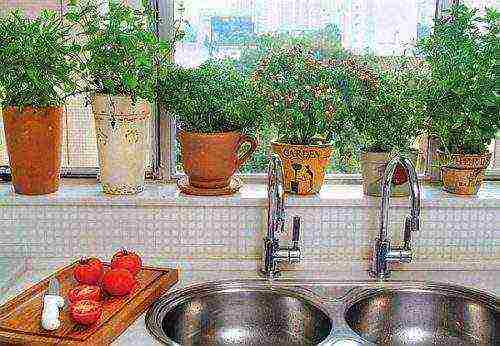
How to grow parsley on the window
To grow parsley in pots, you need a mixture of one part of peat, the same amount of humus and twice the amount of garden soil, disinfected with a solution of potassium permanganate. But it's easier to buy a ready-made universal primer.
When choosing seeds, give preference to early, fast-maturing varieties. This information is indicated on the packaging. Low-grade species and curly parsley look beautiful. It is important that the selected variety can easily tolerate frequent pruning, because you will constantly pluck the leaves to decorate dishes.
Optimal varieties for indoor conditions:
- Appetizing;
- Vorozheya;
- Aster;
- Gloria;
- Nastenka;
- Station wagon;
- Russian feast.
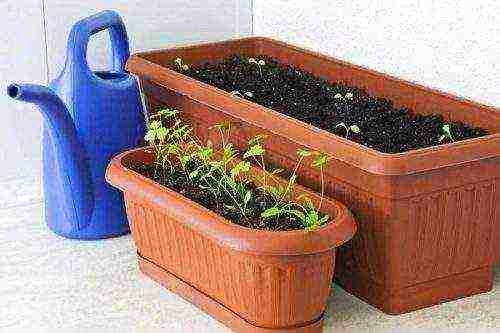
To increase the germination of parsley, experienced gardeners are advised to keep the seeds warm in a damp cloth for two or three days. Then you need to squeeze out excess water, place a cloth with seeds in a bag and put in the refrigerator for several days.
Basic rules for growing parsley on the windowsill:
- Choose containers for planting with a height of at least 15 cm.
- During planting, be sure to keep the distance between the holes at least 5 cm.
- Deepen the seeds to a depth of 0.7-1.4 mm.
- Immediately after sowing, cover the pot with foil or a special plastic greenhouse and place it on a lighted windowsill.
- Provide a temperature of 17-21 degrees.
- Moisten crops, but not liberally, otherwise mold will form. Remove the film every day, providing air access.
- With proper care, parsley shoots will appear in one and a half to two weeks. The film can be removed.
- Water your greens two to three times a week. Provide supplemental food once a month.
- The optimum temperature for indoor parsley is 15-18 ° C during the day and 10-12 ° C at night.
- Make sure that the greens are not attacked by pests. Spider mites are often transferred from other plants to parsley.

When harvesting, try not to rip off the tops, but thin out ranks... This will improve the conditions for further growth.
Features of growing dill in an apartment
When choosing which greens can be grown on the windowsill in winter, pay attention to dill - the second most popular spice in the kitchen.
To enjoy the summer aroma in a month, buy varieties with fast ripening: Gribovsky, Carousel, Early miracle, Aurora, Grenadier. You can plant varieties with different ripening periods on the same windowsill, in order to first use the early ones, and then switch to the later ones, which will just have time to grow up.
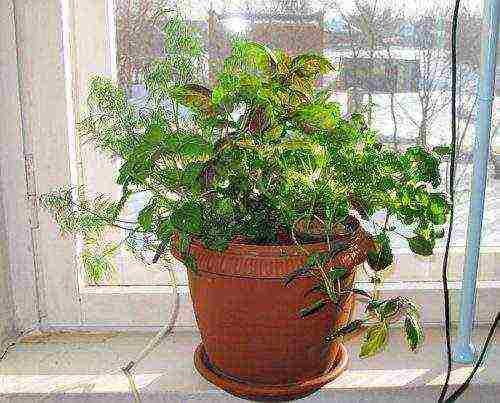
- To select good seeds, soak them in warm water for two days, changing the water to fresh water every 12 hours. Throw away everything that comes up mercilessly, and use the rest of the material for planting.
- Moisten the soil in the pots and make holes 1-1.5 cm deep, leaving gaps of about 4 cm.
- Cover with soil, sprinkle with water and cover with plastic as described above for parsley.
- Place in a warm (18 to 20 degrees) place protected from sunlight for a week.
- When shoots appear, remove the film and place the pot of herbs on the windowsill. If it seems that there are a lot of sprouts, thin out, leaving a space of about 3 cm around each sprout.
- Water as the soil dries. It is better to take a spray bottle as an assistant so as not to damage young seedlings.
- Turn the pot with opposite sides to the sun so that the dill grows evenly.
- Fertilize once every 30-45 days.
Fragrant basil on the window
Basil is another popular choice for growing fresh greenery on a windowsill in a city apartment setting. There are many varieties of basil in nature, but only a few dozen are suitable for human consumption. The leaves of the plant are used in cooking, they are ideal for salads, and for meat dishes, and for marinades.
The best varieties for a room are:
- Marquis - is distinguished by its compactness and beautiful shape of the ball;
- A dwarf is a low bush, there are species with greenery of a purple tide;
- Clove - attracts with a pleasant aroma and high decorativeness.
- Lemon - delicate scent of lemon and crown with beautiful light green leaves.
- Purple is a bright bush with large leaves.
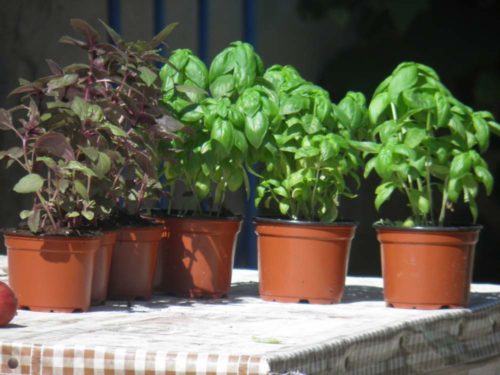
Basil seeds are different long germination... To speed up the process, keep the seed in a warm place for 10-14 days, then soak in warm water for a day. Throw away the floating instances.
- Make holes in the soil and plant the seeds about 3 cm apart. It is unnecessary to do large intervals, since not all crops will sprout.
- Make a polyethylene greenhouse to accelerate germination. The plant loves light and warmth - provide a temperature of 25 ° C.
- Moisten the mini-bed as it dries.
- When the basil rises, thin out the excess so that there is 5 cm of free space around each plant.
- Place on a well-lit windowsill and regularly look after the plantings - water, turn, fertilize, loosen the soil. Heat water for irrigation to 30 ° С.
- Basil loves light, so be sure to install a backlight lamp on the windowsill and provide at least 15 hours of daylight.
For culinary purposes pick off the leaves from the tops of the bush... This will prevent blooming, which makes the grass unfit for food.
Ideal salad variety for home growing
If you are planning to plant greens on the windowsill for the first time, pay attention to watercress. This is one of the most unpretentious and fastest growing plants. Watercress seeds do not require long soaking, and seedlings are resistant to temperature fluctuations and light. The best varieties: Pepper, Ordinary, Broadleaf, Curly.
- To get a bountiful harvest, soak watercress seeds in a mild potassium permanganate solution for a couple of hours.
- Make good drainage at the bottom of the pot and fill it with flower soil from a bag or a mixture of two parts coconut fiber and one vermicompost.
- Prepare holes 5-10 mm deep, sow basil and sprinkle with soil. Moisten and cover with plastic wrap.
- The first micro-greens on the windowsill will appear in a week. Keep the pot at 17-20 degrees.
- The higher the temperature, the more watering should be.

Watercress is one of the most unpretentious plants, it can be grown without land at all. Someone does it right in the water, and someone on foam rubber. But in a pot on the kitchen windowsill, greens look more attractive.
How to get green onions quickly in winter
To grow onion greens at home on the windowsill, you can use two options - in the soil in a pot and in water. The second method is very fast and is well known to everyone from childhood. You just need to fill the glasses with water and place the bulbs in them. Better to take those that have already begun to germinate.
Nuances of growing luka in the water:
- The water should be warm - about 40 degrees.
- If the bulb has not yet begun to germinate, it is recommended to cut the top by 1.5 cm.
- Only the roots should be in the water; the bulb should not be immersed more than one third.
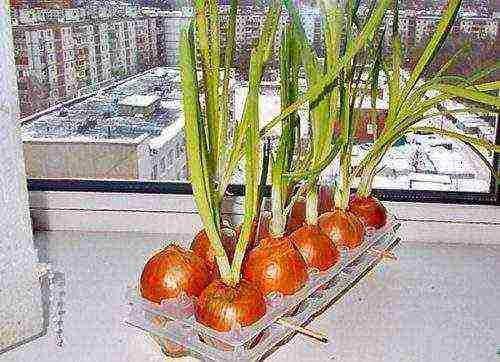
By the way, in the same way, you can grow an avocado from a stone at home and get a beautiful tree.
Instead of jars, it is convenient to use egg packs or special pots for growing onions at home. This is a container with holes for the bulbs. Looks neat and beautiful on the windowsill.
It is longer and more difficult to grow green onions in soil. Use bulbs for planting, as the harvest from the seeds may not wait at all.
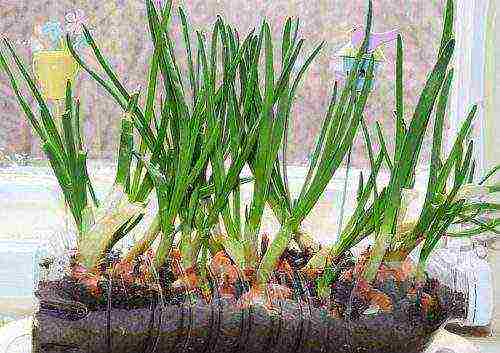
See the video for planting bulbs on greens in a bottle.
Fragrant mint in the home kitchen
An excellent choice for home - mint with a wonderful aroma. Mint is a perennial plant that is easy to grow on a windowsill using root cuttings or seeds. The second method will take more time, but it will also bring more pleasure.
For growing mint, peat or loose humus soil with an acidity of no more than 5-6 pH is suitable. Feel free to buy a universal primer in the store and do not worry. The ideal temperature is 18-25 degrees. Plant good lighting required.
- You need to divide the bush in the fall after the completion of the growing season. Divide the rhizomes carefully so that each portion contains dormant buds.
- Fill the pots two-thirds full with nutrient soil.
- Spread out the seedlings carefully and cover them with soil.
- Drizzle with warm water.
The first leaves should appear in about two weeks.
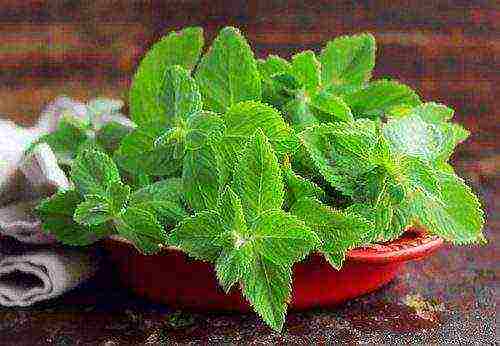
If you bought a bunch of fresh mint, then try to get planting material using the method cuttings... Simply place a few twigs in the water by dipping them into a root stimulator (root). The roots will appear in 8-14 days. All that remains is to plant the seedlings in pots.
- Sowing mint seeds for growing on a windowsill is best in mid-spring.
- Fill the pot with soil, prepare the wells 0.5 cm deep and moisten the soil.
- Sow the seeds and sprinkle on top with a little of the same soil.
- Cover with a plastic greenhouse.
- At a temperature of 19-25 degrees, seedlings will appear a couple of weeks after sowing.
- Control the moisture content of the ground, avoid drying out and excessive moisture. Water using a spray method to avoid diluting crops.
When growing mint in winter, do not over-water it. Let the soil dry out slightly. Avoid drafts. Water liberally in summer, but protect fresh greens from excess direct sunlight. If conditions permit, use mint to create a fragrant atmosphere in the garden on the balcony.
What else can be grown on a windowsill in an apartment
If you are going to grow greens on the windowsill in winter, you can choose almost any type of fast growing spicy herbaceous plants. Oregano and sage celebrate themselves well in the apartment, they are not demanding of light and withstand partial shade.
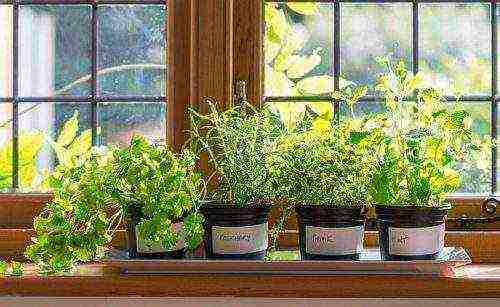
Unpretentious fragrant melissa... Lemon balm seeds just need to be sown into the soil to a depth of 0.5 cm without presoaking, watered and moistened regularly. The greens will hatch in days. Melissa loves light, a lack of it reduces the production of essential oils that impart fragrance to the leaves.
It will require care, but it looks very original on the window celery... The easiest way to get celery greens is in water. Just cut the root off the stem and leave it in a container of water in a sunny place. In a few days, new shoots and roots will appear.You can transplant the plant into soil or leave it in water. Cut green leaves as needed and groom if transplanted.
Green seeds cost a penny. Try, experiment with different types and planting options. Create your own spicy mini-garden to delight yourself and the envy of passers-by looking in the windows. And for more effect decorate the pots with your own handsusing our selection of ideas. So you will be able to significantly save on the purchase of containers.
Having made it your hobby to grow herbs on the windowsill at home, you will enjoy, decorate the kitchen and always have spicy herbs on hand for salads and soups. This hobby is ideal for joint leisure activities with children and husband. Have a good harvest all year round!
Add this page to your favorites and share interesting information with your friends on social networks!
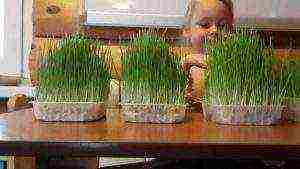
Growing greenery on a windowsill in winter for beginners is a very real task. You just need to create suitable conditions for it and choose those types of it that will feel good even indoors. A mini-vegetable garden on the windowsill today is not only a practical, but also a fashionable solution within the framework of the current eco-trend and the promotion of a healthy lifestyle. Of course, it is very convenient to always have fresh parsley on hand, but at the same time such a garden not only provides the family with fresh herbs and vitamins, but also becomes a decoration of the kitchen.
What greens can you grow at home?
Greenery on the windowsill all year round is not the most difficult task. Of course, each gardener decides for himself which crops will make up this vegetable garden on the window. But you need to take into account the peculiarities of growing one or another greenery at home. The purpose of their breeding is to obtain a high yield, and you need to choose those varieties that ripen quickly.
In most cases, greens at home are grown from seeds. But, of course, it all depends on the culture itself. So, green onions are grown from a bulb. This is generally one of the most common garden crops that grow on windowsills. On the one hand, it is very easy to grow, on the other hand, it is a whole storehouse of vitamins. Many housewives are afraid to grow it because of the unpleasant smell, but it only occurs when the bulbs are kept in water for too long. And if it is grown in the ground, then there will be no smell.
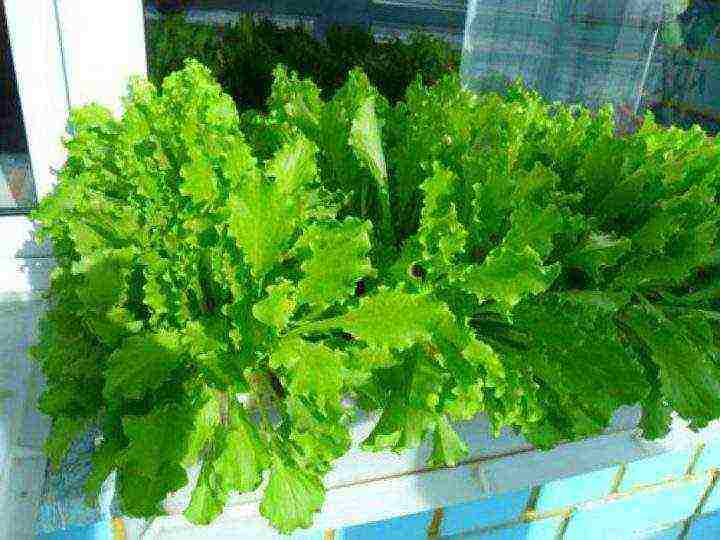
Leaf salad
A home garden on the window often includes spinach. This is one of the most common types of greenery, as it sprouts quickly and looks beautiful in a pot or neat box.
Dill can also be grown on the windowsill, but only some of its varieties, since it ripens quite late, even in the best case, its first sprouts will appear only a month after sowing.
And, of course, the window garden includes parsley. Unlike other types of greens, it is grown from root vegetables, in which the whole upper bud must be preserved. Dill is grown in fairly tall pots or boxes. But most types of salad do not require this. In addition, it is recommended to use peat tablets or cassettes for them. Experts advise buying several types of lettuce, with leaves of different shapes and colors. Firstly, the plants will look more decorative, and secondly, the greenery on the windowsill will be all year round, since different species differ in terms of ripening. The most unpretentious type is watercress. It does not grow so luxuriantly, but because of the characteristic shape of its small leaves, the pot of greenery looks curly.
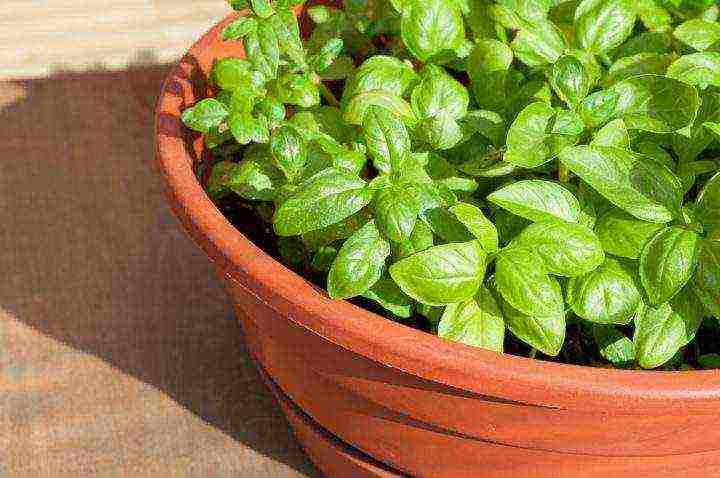
Growing basil
In theory, a window garden could include more crops. But not all of them will grow in winter lighting conditions. And some for normal development need a stable above-zero temperature outside the window. This applies to crops such as arugula. basil, watercress, marjoram and thyme.To make the seeds of these crops germinate faster, they arrange something like a mini-greenhouse, covering the pots with a film, under which there will be a comfortable temperature and humidity for these species.
General rules for growing greens
The garden on the window is not difficult at all, the main thing is to follow the general recommendations. You can grow greens in ordinary flower pots, and in wooden boxes, which should be not only convenient, but also beautiful. In addition, the drawers should be made in such a way as to keep out water. It is very important to choose the right pot parameters. The optimal length of the container for most types of greenery is 40-50 cm. The width should be 20-25 cm, and the height should be 12-15 cm. A drainage hole must be made the day before. In such a pot or container, a drainage layer must be arranged. To do this, use expanded clay, broken brick or even just coarse clean sand.
It is not enough to know how to grow greens at home, you also need to be able to find the optimal place for it. As a rule, greens prefer warmth and sunlight, so it is better to grow them in a south or southwest window.
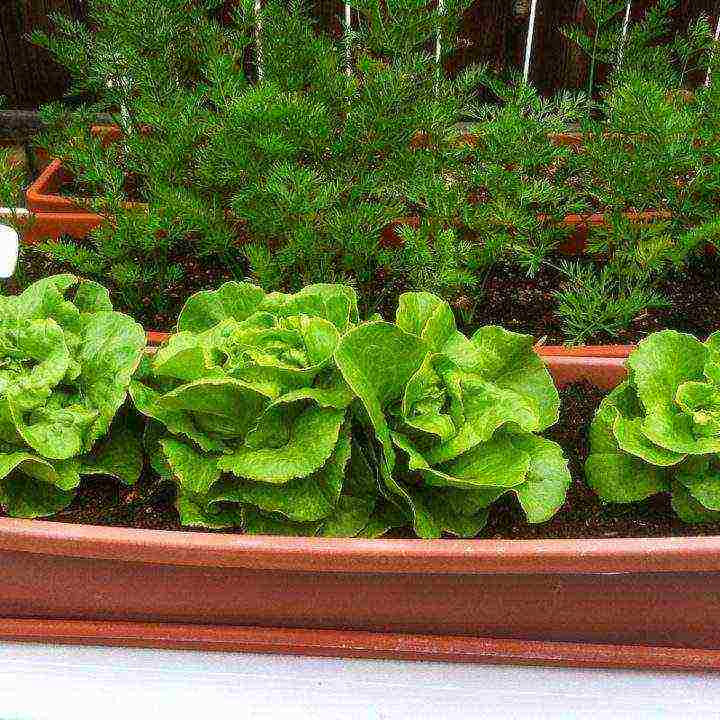
Kitchen garden on the windowsill
Before planting, it is imperative to water the soil prepared for distillation with hot water, then crush it and make grooves in it: then seeds are poured into them, and a layer of earth about a centimeter thick is added on top.
Greens are usually watered every other day, usually in two doses and in small portions. Some seeds are recommended to be warmed up before planting and first germinate in damp gauze. But this mainly applies to crops such as asparagus.
Growing greenery at home means creating the most comfortable conditions for it. For example, most of these crops are harmed by dry heat from radiators. In order not to harm the plants, the battery can be covered with a special shield and a humidifier can be used. This is also useful for creating a comfortable microclimate in scrap. If it is not possible to buy such a device separately, you can make an impromptu humidifier by simply putting a piece of wet cloth on the battery.
In winter, greenery lacks light. Therefore, many plants grow pale, and there may be less vitamins in them. In such cases, additional illumination using ultraviolet lamps is used. For most crops, the optimal daylight hours are 12-16 hours.
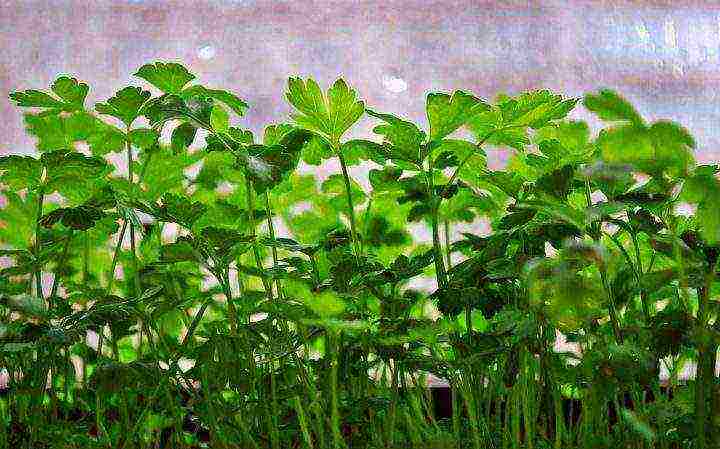
Lovage
However, pale leaves can mean chlorosis, which often occurs due to problems in the acidity of the water. The fact is that tap water is often a more alkaline medium, and therefore a number of nutrients (phosphorus, manganese, iron, boron) cease to dissolve in the soil, plants do not receive them, and this affects their condition. In this case, you need to take care of the water for irrigation; in extreme cases, you will need to add special phyto-mixtures to it.
With home-grown crops, you can safely replenish your diet. Firstly, in this case it is known for sure that all this was grown without chemistry. Secondly, greens that were picked and used almost immediately retain more vitamins than those that have been in the store for a long time.
How to grow parsley?
As you know, parsley is a real storehouse of vitamins. The composition of this plant includes ascorbic acid and vitamins A and E, which are antioxidants, and B vitamins, and phosphorus, and potassium. Of course, every housewife wants such greens to be always at hand. Growing parsley is easy, but remember that its seeds take much longer to germinate than other green crops, due to the high content of essential oils. There are two options for growing it: from a root crop and by accelerating seed germination. When choosing the second option, the seeds must be thoroughly rinsed with water and wrapped in a damp cloth.

Growing parsley
The soil for growing parsley is prepared in advance. You can take ordinary garden soil, but it will need to be additionally treated with a weak solution of potassium permanganate for disinfection. You can buy ready-made soil for such crops, which is sold in garden centers.
There shouldn't be any difficulties with growing parsley. You just need to take the container a little higher than usually taken for greens - 20 cm high. A drainage layer is placed at the bottom of the container, then covered with earth. After the soil is ready, you can plant the seeds. To do this, make beds with a distance of 10 cm from each other. Seeds are planted to a depth of no more than 1 cm. The soil is watered before planting, as described above. In the future, until shoots appear, the earth is watered every other day from a sprayer. After sprouting, you can already water from a watering can once every two days.
At a temperature of 20 ° C and normal illumination, parsley shoots will appear in 3 weeks.
Growing spinach and onions
Spinach can be grown on the windowsill all year round. This culture has a taproot, which requires compliance with certain rules regarding the selection of pots for it. When caring for plants, it is important not to flood the soil and avoid contact of delicate leaves with water when watering.
Spinach is germinated in boxes or containers at least 10 cm high. Good drainage is very important for it. For this, expanded clay is usually used. Spinach seeds are planted not tightly, but at a distance of 5-10 cm between the rows. Planting depth - 1-2 cm. Under favorable conditions, greens suitable for consumption will appear in 1-1.5 months. The most delicious is the greens obtained from plants with 6-10 true leaves.
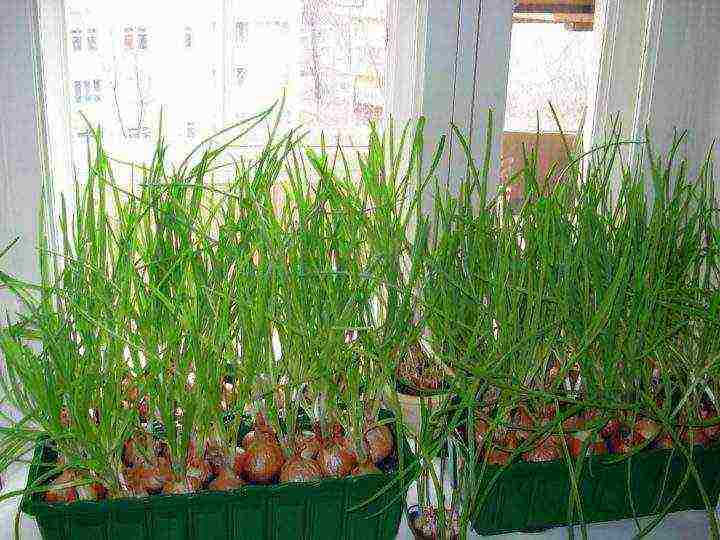
Growing onions
You can choose any onion for planting. The larger the bulbs, the more nutrients they will contain and the more greenery will be grown. But you can also plant small shallots. The ideal option is to choose several varieties at once with different dormant periods so that the greens are on the table all year round.
In theory, onions can also be grown from seeds. But in this case, it should be clarified whether this or that variety can be grown at home.
Growing lettuce and dill
Lettuce greens are tasty and healthy. And there shouldn't be any problems with growing it. However, it must be taken into account that this culture has very small seeds, therefore, later, when shoots appear and the feeding area increases, a pick will need to be made. For these purposes, cassettes are used in which you need to plant seedlings - they choose those that already have 1-2 real leaves with a lump of earth, and one in each cell. Over time, the salad will grow beautifully.
As for dill, not all varieties are suitable for growing on a windowsill. For mini-vegetable gardens, the variety "Grenadier" with light leaves and a delicate aroma and taste, the unpretentious and disease-resistant variety "Gribovsky", the very fragrant variety "Richelieu" with beautiful blue-green leaves resembling lace, as well as the variety "Kibray" containing a huge amount of vitamins.
As with any greenery, you need to prepare the soil to grow dill. The garden soil is disinfected, and this is the most important moment for further harvesting. To do this, it is recommended to treat it with a solution of potassium permanganate, and if it is not there, then ignite it in the oven or microwave. Another option is to treat with hot steam, which is guaranteed to eliminate pests.
A drainage layer is placed at the bottom of the container, then the prepared soil is poured. The seeds are pre-soaked in warm water and left in this state for a day, changing the water every 5-6 hours. Then they are dried with a paper towel or cloth and planted in a pot.
Dill is sown in beds, seeds are sown to a shallow depth, covered with a layer of earth about 2 cm thick on top.This crop requires abundant lighting, so it is usually grown under ultraviolet lamps.
It should be remembered that greenery has a short growing season. Therefore, it has the ability to quickly accumulate nitrates in large quantities. This makes any feeding problematic, including with the help of mineral fertilizers. The soil that is sold in garden centers contains enough minerals. But if in doubt, you can feed the greens with natural fertilizers, in this case, eggshells and tea.
